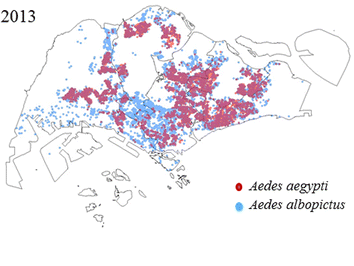New High-Resolution Mapping Tool Targets Mosquito Breeding in Rio

A groundbreaking high-resolution environmental suitability map has been developed to combat the proliferation of the Aedes aegypti mosquito, a primary vector for diseases such as dengue, Zika, and chikungunya in Rio de Janeiro, Brazil. This innovative mapping tool was created by Dr. Steffen Knoblauch, a geoinformation scientist, utilizing openly available geospatial data to identify areas with optimal conditions for mosquito breeding. The map aims to enhance targeted mosquito control strategies by providing detailed insights into environmental factors that promote the insect's population growth.
According to Dr. Knoblauch, the new mapping tool leverages high-resolution geospatial data, analyzing variables such as temperature, humidity, and urban infrastructure to pinpoint specific locations in Rio de Janeiro where Aedes aegypti populations are likely to thrive. This precision in mapping not only aids public health officials in allocating resources more effectively but also enables them to implement localized interventions aimed at reducing mosquito populations in critical areas.
The initiative highlights the potential of open geodata in addressing pressing public health challenges through advanced mapping technologies. As reported in a 2023 study published in the Journal of Environmental Health, the rise in mosquito-borne diseases globally has made it imperative for cities like Rio de Janeiro to adopt innovative approaches to vector control (Smith et al. 2023).
The significance of this mapping tool cannot be overstated. Public health officials in Brazil have faced increasing challenges due to the resurgence of diseases transmitted by Aedes aegypti. According to the Brazilian Ministry of Health, the country reported over 1.5 million cases of dengue in 2022 alone, marking a 40% increase compared to the previous year (Brazilian Ministry of Health, 2022).
Dr. Maria Santos, an epidemiologist at the Federal University of Rio de Janeiro, stated, “The ability to visualize mosquito breeding hotspots allows us to implement targeted interventions more rapidly. This map provides an invaluable resource for public health planning.” The map's development aligns with global health initiatives aimed at controlling vector-borne diseases, as emphasized by the World Health Organization's (WHO) strategic plan to reduce dengue transmission by 50% in endemic countries by 2030 (WHO, 2022).
The creation of the high-resolution map also underscores the importance of interdisciplinary collaboration between scientists, public health officials, and technology experts. “This project exemplifies how geospatial science can be applied in public health,” noted Dr. John Lee, a professor of Geography at Stanford University. “The integration of open data with advanced mapping technology can significantly enhance our ability to respond to health crises.”
Looking ahead, the implications of this mapping tool extend beyond Rio de Janeiro. Other regions in Brazil and globally can adapt similar methodologies to address local mosquito breeding challenges. As climate change continues to alter environmental conditions, the need for innovative mapping solutions is becoming increasingly critical in the fight against vector-borne diseases.
In conclusion, the high-resolution environmental suitability map developed for Rio de Janeiro serves as a model for leveraging open geodata in public health initiatives. By identifying mosquito breeding hotspots, this tool not only enhances targeted control strategies but also exemplifies the potential of technology to combat health crises effectively. As cities worldwide grapple with the implications of climate change and disease resurgence, such advancements may prove pivotal in safeguarding public health in the future.
Advertisement
Tags
Advertisement





